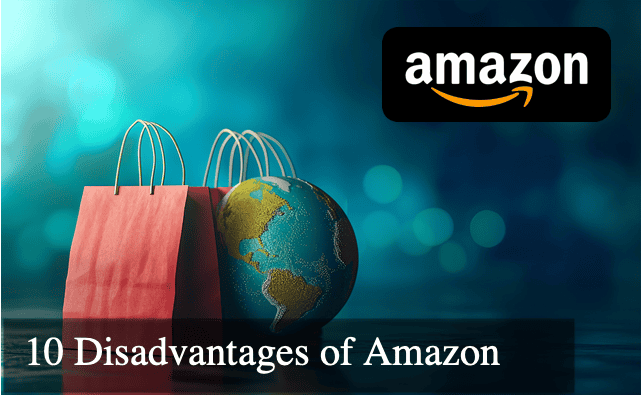Top 10 Cons & Disadvantages of Amazon

Amazon, the global retail giant, has fundamentally transformed how we shop, leveraging its vast network to deliver various products suitable to consumers’ doorsteps. Despite its colossal success and popularity, there are significant drawbacks and disadvantages associated with its operations and market dominance. These issues not only impact consumers and sellers but also the environment and the economy at large. Understanding these cons is crucial for a balanced view of Amazon’s role in modern commerce.
Firstly, Amazon’s impact on local businesses cannot be overstated. Many small retailers find it increasingly difficult to compete with Amazon’s pricing, variety, and convenience. This often leads to decreased foot traffic in local shops, culminating in a downturn for regional economies. Moreover, Amazon’s approach to employee treatment has frequently been criticized, raising concerns about working conditions in its fulfillment centers. Such issues have sparked widespread debate about the ethical considerations of supporting such a behemoth in the retail sector.
10 Disadvantages & Drawbacks of Using Amazon

When assessing the disadvantages of shopping with or selling on Amazon, it’s important to catalog the top issues systematically. These range from anti-competitive practices to the environmental impact of excessive packaging and rapid delivery expectations. Also, Amazon’s data privacy concerns and the potential for counterfeit products complicate the shopping experience. These facets collectively paint a picture of a corporation that, while providing undeniable consumer convenience, also poses significant ethical and practical challenges. Each of these disadvantages merits a detailed discussion to understand their broader implications on society and what measures could be taken to mitigate these issues.
1. Impact on Small Businesses
Amazon’s vast scale and aggressive pricing strategies significantly impact small businesses across various sectors. By offering a wide array of products at lower prices and with greater convenience, Amazon often draws customers away from local shops, leading to a decline in traditional retail.
- Market Dominance: Amazon’s vast selection and competitive pricing often undercut local small businesses, which can’t match Amazon’s scale and efficiency.
- Consumer Behavior: Amazon’s convenience changes consumer shopping habits, leading to less foot traffic for physical stores.
- Economic Shifts: Local economies suffer as sales divert from community-based shops to Amazon, reducing local employment and weakening community ties.
Real-life example: One real-life example of this issue is the closure of several independent bookstores and small retailers in urban and suburban areas, directly tied to the competitive pressure exerted by Amazon. These businesses often struggle to compete with Amazon’s aggressive pricing strategies and the convenience of online shopping, leading to their eventual shutdown.
Solution: To resolve this disadvantage, fostering support for local businesses through consumer education about the benefits of buying locally could be crucial. Additionally, implementing fairer taxation policies on mega-retailers like Amazon could level the playing field, giving smaller businesses a better chance to compete. Promoting local online marketplaces as alternatives to Amazon is another viable strategy to bolster local economies.
2. Worker Exploitation
Amazon has often been criticized for its treatment of warehouse workers. Employees have reported grueling work conditions, unreasonable quotas, and inadequate breaks, which contribute to high-stress levels and physical injuries. The drive for fast, efficient delivery comes at the human cost of worker well-being.
- High Quotas: Workers must pick or pack hundreds of items per hour, leading to physical and mental exhaustion.
- Limited Breaks: Short breaks do not allow sufficient rest, contributing to burnout and injuries.
- Surveillance: Intense monitoring and tracking of employee performance create a pressured and invasive work environment.
Real-life example: A reported instance involves workers in several Amazon warehouses striking to protest against unsafe working conditions, particularly during peak shopping seasons like Black Friday and Prime Day.
Solution: To address these issues, Amazon could improve working conditions by reducing quotas, extending break times, and employing humane surveillance practices. A robust worker feedback system that directly addresses grievances could also enhance workplace satisfaction and safety.
3. Environmental Impact
Amazon’s rapid delivery model often results in increased carbon emissions due to prioritizing speed over shipping efficiency. Excessive packaging materials further contribute to environmental degradation.
- Carbon Footprint: Frequent, expedited shipping options increase the number of delivery vehicles on the road.
- Waste Production: Extensive use of packaging materials, much of which is non-recyclable, contributes significantly to waste.
- Energy Consumption: The vast network of Amazon warehouses consumes large amounts of energy.
Real-life example: Environmentalists point to Amazon’s massive carbon footprint during annual events like Prime Day, where the surge in deliveries exponentially increases CO2 emissions.
Solution: Amazon could adopt more sustainable practices by optimizing delivery routes, using eco-friendly packaging, and investing in renewable energy sources for its operations.
4. Market Monopoly
Amazon’s dominance in multiple sectors stifles competition, potentially leading to monopolistic behaviors. Smaller companies struggle to compete, and innovation suffers as Amazon consolidates its market power.
- The barrier to Entry: New startups find it challenging to break into markets where Amazon has a significant presence.
- Pricing Control: With fewer competitors, Amazon can dictate market prices, often to the detriment of both consumers and suppliers.
- Acquisition of Competitors: Amazon frequently acquires rising competitors, further entrenching its market dominance.
Real-life example: Critics often cite Amazon’s buyout of Whole Foods as a clear move to monopolize the grocery delivery sector, pushing out smaller and local grocers.
Solution: To mitigate these effects, regulatory bodies could enforce stricter antitrust laws and encourage diversity in the marketplace by supporting small and mid-sized enterprises.
5. Data Privacy Concerns
Amazon collects vast amounts of data from its users, raising significant privacy concerns. This data is used to manipulate market trends and consumer behavior without transparent disclosure to users.
- User Tracking: Amazon tracks user activity across its platforms to tailor marketing and increase sales.
- Data Sharing: Information about consumers may be shared with third-party advertisers without explicit consent.
- Security Risks: Large data stores are attractive targets for cyberattacks, posing risks to personal information.
Real-life example: An example of these concerns came to light when it was revealed that Amazon Alexa devices were storing and analyzing private conversations.
Solution: To combat these issues, Amazon could implement stronger data protection policies, limit data retention periods, and give users more control over their personal information.
6. Impact on Innovation
While Amazon does foster some technological advancements, its market dominance can stifle innovation elsewhere. Smaller companies might hesitate to introduce new products if they cannot compete with Amazon’s vast resources and market reach.
- Copycat Products: Amazon has been accused of replicating successful products sold by smaller vendors on its platform.
- Suppressing Startups: New businesses may be deterred from entering the market due to fear of being overshadowed or acquired by Amazon.
- Resource Allocation: Amazon’s focus on maintaining dominance can divert resources from innovative projects.
Real-life example: Several small tech companies have accused Amazon of using its platform to copy their product ideas and undercut them on price.
Solution: To encourage innovation, Amazon could establish more explicit boundaries and protections for third-party sellers and startups, promoting a more collaborative rather than competitive business environment.
7. Dependence on Amazon Services
Amazon’s vast array of services, including AWS, Prime, and its online marketplace, creates a dependency that can be hard to break. This dependency limits choices for both consumers and businesses.
- Service Interruptions: Outages in AWS, for example, can cripple numerous online services and businesses.
- Vendor Lock-in: Companies using Amazon’s infrastructure may find it difficult and costly to switch providers.
- Consumer Habituation: Consumers accustomed to Amazon’s ecosystem might overlook or avoid alternative options.
Real-life example: In recent years, a significant AWS outage disrupted thousands of online services globally, highlighting the risks of over-reliance on a single provider.
Solution: Reducing this dependency could involve diversifying service providers and encouraging consumers to explore and support alternative platforms.
8. Quality Control Issues
The vast quantity of products available on Amazon can lead to inconsistencies in product quality, particularly when third-party sellers are involved.
- Counterfeit Goods: The platform has struggled with counterfeit products, which can deceive consumers and harm legitimate manufacturers.
- Inconsistent Product Standards: Not all products sold on Amazon meet the same quality standards, leading to customer dissatisfaction.
- Lack of Oversight: Amazon cannot effectively monitor or control all seller activities with millions of products listed.
Real-life example: Numerous complaints have been lodged by consumers who received counterfeit items, especially in categories like cosmetics and electronics.
Solution: Strengthening seller vetting processes and improving quality assurance protocols could help Amazon address these quality issues.
9. Overwhelming Product Choices
The sheer volume of products available on Amazon can overwhelm consumers, making it difficult to make informed purchasing decisions.
- Analysis Paralysis: Too many options can lead to decision fatigue, where consumers cannot choose.
- Misleading Reviews: The prevalence of fake or paid reviews can mislead consumers about the quality of products.
- Complex Navigation: Finding the right product among millions can be daunting and time-consuming.
Real-life example: Customers often feel overwhelmed by the multiple choices and conflicting reviews, as evidenced by feedback on popular electronic items with thousands of mixed reviews.
Solution: Amazon could improve the shopping experience by refining its search algorithms, enhancing review verification processes, and simplifying product categories.
10. Ethical Concerns
Amazon’s business practices have raised various ethical concerns, from the treatment of employees to its environmental impact and influence on consumer behavior.
- Labor Practices: The company’s labor practices, especially in its warehouses, have been a point of contention.
- Environmental Degradation: Amazon’s operations have a considerable ecological footprint, including packaging waste and delivery vehicle emissions.
- Consumer Manipulation: Amazon’s algorithms are designed to maximize sales, which can manipulate consumer purchasing decisions.
Real-life example: An example of these ethical dilemmas includes the criticism Amazon faced for its decision to continue selling facial recognition technology to law enforcement agencies.
Solution: Amazon could address these ethical issues by implementing fairer labor policies, adopting more sustainable business practices, and ensuring greater transparency in its algorithms and product recommendations.
How Could these Disadvantages be Overcome Globally?
Overcoming the disadvantages associated with Amazon’s operations requires concerted efforts from various stakeholders, including governments, the company, consumers, and the broader community. Global strategies should promote fair competition, ethical practices, and sustainability. Here are five ways these goals could be achieved:
- Regulatory Enforcement: Governments can enforce stricter regulations to prevent monopolistic practices and ensure fair competition.
- Corporate Responsibility: Amazon can increase its corporate responsibility by improving working conditions, embracing sustainable practices, and ensuring data privacy.
- Consumer Awareness: Educating consumers about the impact of their purchases and the importance of supporting local businesses.
- Technological Innovations: Developing new technologies that improve efficiency without compromising employee welfare or environmental standards.
- Global Standards: Implementing global standards for labor and environmental practices that all companies, including Amazon, must follow.
These actions would help mitigate the negative impacts of Amazon’s business model and ensure it contributes positively to society and the economy.
Top 5 Best Amazon Marketing Agencies
Navigating Amazon’s competitive marketplace requires expertise and strategic marketing to stand out. This is where Amazon marketing agencies come into play, offering specialized services to enhance visibility, optimize listings, and drive sales. These agencies are crucial for businesses aiming to thrive on the platform. They employ cutting-edge techniques and deeply understand Amazon’s complex algorithms. Below, we explore the top five Amazon marketing agencies known for their proven track records, innovative approaches, and exceptional service in helping brands succeed on Amazon.
- Thrive Agency: Thrive Agency excels in comprehensive Amazon account management and advertising solutions. They help clients increase their product visibility and sales with customized strategies that focus on maximizing ROI.
- Acadia: Acadia offers a full-service approach to Amazon marketing, from PPC campaigns to inventory management. They are renowned for their detailed attention to client needs and consistent performance in boosting Amazon sales.
- Seller Labs: Seller Labs specializes in providing innovative tools and services that aid Amazon sellers in increasing discoverability and managing advertising campaigns effectively. Their solutions are tailored to the needs of both new and established sellers.
- Channel Bakers: Channel Bakers uses a combination of AI technology and market insights to deliver targeted advertising and content optimization strategies. Their expertise in navigating Amazon’s ecosystem makes them a top choice for brands looking to improve their market share.
- Ignite Visibility: Ignite Visibility offers a robust suite of Amazon marketing services, focusing on driving traffic and increasing sales through optimized listings and strategic advertising. Known for their detailed analytics and result-oriented campaigns, they help brands maximize their presence and profitability on Amazon.
What is Amazon?
Amazon is a global e-commerce and cloud computing giant founded by Jeff Bezos in 1994. Originally a bookstore, it has expanded to become the largest online retailer in the world, offering everything from electronics to groceries. Amazon is also known for its technology innovation, especially in areas like cloud computing, artificial intelligence, and logistics. Its influence extends beyond retail, impacting industries such as entertainment with Amazon Prime Video and its Amazon Web Services (AWS) technology. However, this extensive reach has not come without criticism; issues range from labor practices to market dominance and data privacy concerns. Understanding Amazon’s complex role in the global economy is crucial for evaluating its impact on daily life and international commerce.
- E-commerce Giant: Dominates global online retail.
- Cloud Computing Leader: Operates AWS, the largest cloud computing service in the world.
- Innovative Technology: Develops cutting-edge technology in AI, logistics, and beyond.
- Media Producer: Produces films, TV shows, and broadcasts via Amazon Prime.
- Controversial Employer: Criticized for labor practices and workplace conditions.
A real-life example of Amazon’s influence is its effect on local businesses during the COVID-19 pandemic. While many small shops were forced to close, Amazon’s sales and profits soared as consumers turned to online shopping, highlighting the company’s influential position in the retail sector.
Videos about Amazon
Various videos about Amazon can be found across multiple platforms, including documentaries, news reports, and expert analyses. These videos often discuss Amazon’s business strategies, controversies surrounding its labor practices, and its impact on local and global economies. They also cover innovations introduced by Amazon in areas like AI, logistics, and cloud computing. Educational videos explain how Amazon uses technology to dominate various sectors. Reviews and behind-the-scenes content provide insights into the company’s internal operations and its broader cultural and economic implications.
Conclusion
Amazon’s vast reach and influence across the global market come with significant advantages and drawbacks. While it offers unmatched convenience and a wide array of products, the negative impacts on local businesses, labor practices, and the environment are significant. It is imperative that these issues are addressed through global cooperation, stricter regulations, and a commitment to ethical practices from Amazon itself.
The discussion around Amazon is complex, involving economic, social, and technological dimensions. As consumers, it’s essential to remain aware of these impacts and consider them in our purchasing decisions. By supporting policies that encourage fair business practices and innovation, we can help shape a market that benefits all stakeholders involved.
Recommended articles: Top 10 Cons & Disadvantages of Facebook | Top 10 Cons & Disadvantages of TikTok



